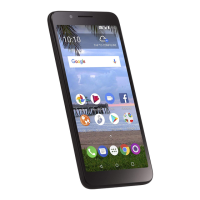70 71
US Information Concerning the Federal CommunicationsCommission (“FCC”)
Requirements for Hearing Aid Compatibility with Wireless Devices
When wireless devices are used near hearing devices (such as hearing aids and cochlear implants),
users may detect a buzzing, humming, or whining noise. Some hearing devices are more immune
than others to this interference, and wireless devices also vary in the amount of interference that
they generate.
The wireless telephone industry has developed ratings to assist hearing device users in finding
wireless devices that may be compatible with their hearing devices. Not all wireless devices have
been rated. Wireless devices that are rated will have the rating displayed on the box together with
other relevant approval markings.
The ratings are not guarantees. Results will vary depending on the user’s hearing device and hearing
loss. If your hearing device is vulnerable to interference, you may not be able to use a rated wireless
device successfully. Consulting with your hearing health professional and testing the wireless device
with your hearing device is the best way to evaluate it for your personal needs.
This smartphone has been tested and rated for use with hearing aids for some of the wireless
technologies that the smartphone uses. However, other wireless technologies may be used in this
smartphone that have not been tested for use with hearing aids. It is important to try the different
features of your smartphone thoroughly and in different locations to determine if you hear any
interfering noise when using this smartphone with your hearing aid or cochlear implant. Consult
your wireless service provider about its return and exchange policies, and for information about
hearing aid compatibility.
Hearing aid compatibility rating for this smartphone: M4/T4
How the ratings work
M-Ratings: Wireless devices rated M3 or M4 meet FCC requirements and are likely to generate
less interference to hearing devices than wireless devices that are not labeled. M4 is the better or
higher of the two ratings.
T-Ratings: Wireless devices rated T3 or T4 meet FCC requirements and are likely to be more usable
with a hearing device’s telecoil (“T Switch” or “Telephone Switch”) than unrated wireless devices. T4
is the better or higher of the two ratings. (Note that not all hearing devices have telecoils in them.)
Hearing devices may also be measured for immunity to this type of interference. Your hearing device
manufacturer or hearing health professional may help you find results for your hearing device. The
more immune your hearing aid is, the less likely you are to experience interference noise from
wireless devices.
For more information about the actions that the FCC has taken with regard to hearing aid
compatibility with wireless devices and other steps that the FCC has taken to ensure that individuals
with disabilities have access to telecommunications services, visit www.fcc.gov/cgb/dro.
SAR Information
0.60 W/kg @ 1g (HEAD)
1.00 W/kg @ 1g (BODY)
THIS MODEL DEVICE MEETS THE GOVERNMENT’S REQUIREMENTS FOR EXPOSURE TO RADIO WAVES.
For body worn operation, this phone has been tested and meets the FCC RF exposure guidelines
when used with the TCL Mobile Limited. Accessories supplied or designated for this product. Use of
other accessories may not ensure compliance with the FCC RF exposure guidelines.
Your wireless mobile phone is a radio transmitter and receiver. It is designed and manufactured
not to exceed the emission limits for exposure to radio frequency (RF) energy set by the Federal
Communications Commission of the U.S. Government. These limits are part of comprehensive
guidelines and establish permitted levels of RF energy for the general population. The guidelines
are based on the safety standards previously set by both U.S. and international standards bodies:
American National Standards Institute (ANSI) IEEE. C95.1-1992 .
National Council on Radiation Protection and Measurement (NCRP). Report 86. 1986.
International Commission on Non-Ionizing Radiation Protection (ICNIRP) 1996.
Ministry of Health (Canada), Safety Code 6. The standards include a substantial safety margin
designed to assure the safety of all persons, regardless of age and health.
The exposure standard for wireless mobile phone employs a unit of measurement known as the
Specific Absorption Rate, or SAR. The SAR limit set by the FCC is 1.6 W/kg*.
The FCC has granted an Equipment Authorization for this model device with all reported SAR levels
evaluated as in compliance with the FCC RF exposure guidelines. SAR information on this model
device is on file with the FCC and can be found under the Display Grant section of https://fjallfoss.
fcc.gov/oetcf/eas/reports/GenericSearch.cfm after searching on FCC ID: 2ACCJH086 Additional
information on Specific Absorption Rates (SAR) can be found on the Cellular Telecommunications &
Internet Association (CTIA) Web-site as http://http://www.ctia.org/.
* In the U.S. and Canada, the SAR limit for mobile phone used by the public is 1.6 Watts/kg (W/kg)
averaged over one gram of tissue. The standard incorporates a substantial margin of safety to give
additional protection for the public and to account for any variations in usage.
Normal condition only to ensure the radiative performance and safety of the interference. As with
other mobile radio transmitting equipment, users are advised that for satisfactory operation of the
equipment and for the safety of personnel, it is recommended that no part of the human body be
allowed to come too close to the antenna during operation of the equipment.
Body-worn Operation
This device was tested for typical body-worn operations. To comply with RF exposure requirements,
a minimum separation distance of 10 mm must be maintained between the user’s body and the
handset, including the antenna. Third-party belt-clips, holsters, and similar accessories used by this
device should not contain any metallic components. Body-worn accessories that do not meet these
requirements may not comply with RF exposure requirements and should be avoided.

